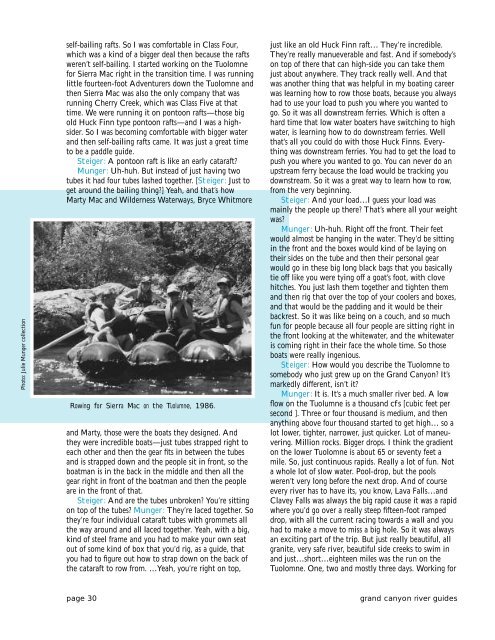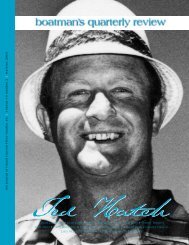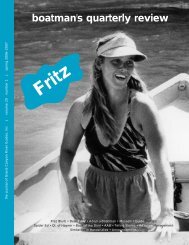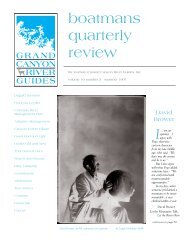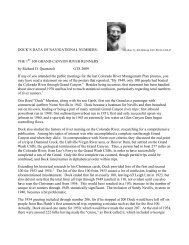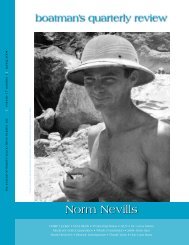summer 07 / 20:2 - Grand Canyon River Guides
summer 07 / 20:2 - Grand Canyon River Guides
summer 07 / 20:2 - Grand Canyon River Guides
Create successful ePaper yourself
Turn your PDF publications into a flip-book with our unique Google optimized e-Paper software.
Photo: Julie Munger collection<br />
self-bailing rafts. So I was comfortable in Class Four,<br />
which was a kind of a bigger deal then because the rafts<br />
weren’t self-bailing. I started working on the Tuolomne<br />
for Sierra Mac right in the transition time. I was running<br />
little fourteen-foot Adventurers down the Tuolomne and<br />
then Sierra Mac was also the only company that was<br />
running Cherry Creek, which was Class Five at that<br />
time. We were running it on pontoon rafts—those big<br />
old Huck Finn type pontoon rafts—and I was a highsider.<br />
So I was becoming comfortable with bigger water<br />
and then self-bailing rafts came. It was just a great time<br />
to be a paddle guide.<br />
Steiger: A pontoon raft is like an early cataraft<br />
Munger: Uh-huh. But instead of just having two<br />
tubes it had four tubes lashed together. [Steiger: Just to<br />
get around the bailing thing] Yeah, and that’s how<br />
Marty Mac and Wilderness Waterways, Bryce Whitmore<br />
Rowing for Sierra Mac on the Tuolumne, 1986.<br />
and Marty, those were the boats they designed. And<br />
they were incredible boats—just tubes strapped right to<br />
each other and then the gear fits in between the tubes<br />
and is strapped down and the people sit in front, so the<br />
boatman is in the back in the middle and then all the<br />
gear right in front of the boatman and then the people<br />
are in the front of that.<br />
Steiger: And are the tubes unbroken You’re sitting<br />
on top of the tubes Munger: They’re laced together. So<br />
they’re four individual cataraft tubes with grommets all<br />
the way around and all laced together. Yeah, with a big,<br />
kind of steel frame and you had to make your own seat<br />
out of some kind of box that you’d rig, as a guide, that<br />
you had to figure out how to strap down on the back of<br />
the cataraft to row from. …Yeah, you’re right on top,<br />
just like an old Huck Finn raft… They’re incredible.<br />
They’re really manueverable and fast. And if somebody’s<br />
on top of there that can high-side you can take them<br />
just about anywhere. They track really well. And that<br />
was another thing that was helpful in my boating career<br />
was learning how to row those boats, because you always<br />
had to use your load to push you where you wanted to<br />
go. So it was all downstream ferries. Which is often a<br />
hard time that low water boaters have switching to high<br />
water, is learning how to do downstream ferries. Well<br />
that’s all you could do with those Huck Finns. Everything<br />
was downstream ferries. You had to get the load to<br />
push you where you wanted to go. You can never do an<br />
upstream ferry because the load would be tracking you<br />
downstream. So it was a great way to learn how to row,<br />
from the very beginning.<br />
Steiger: And your load…I guess your load was<br />
mainly the people up there That’s where all your weight<br />
was<br />
Munger: Uh-huh. Right off the front. Their feet<br />
would almost be hanging in the water. They’d be sitting<br />
in the front and the boxes would kind of be laying on<br />
their sides on the tube and then their personal gear<br />
would go in these big long black bags that you basically<br />
tie off like you were tying off a goat’s foot, with clove<br />
hitches. You just lash them together and tighten them<br />
and then rig that over the top of your coolers and boxes,<br />
and that would be the padding and it would be their<br />
backrest. So it was like being on a couch, and so much<br />
fun for people because all four people are sitting right in<br />
the front looking at the whitewater, and the whitewater<br />
is coming right in their face the whole time. So those<br />
boats were really ingenious.<br />
Steiger: How would you describe the Tuolomne to<br />
somebody who just grew up on the <strong>Grand</strong> <strong>Canyon</strong> It’s<br />
markedly different, isn’t it<br />
Munger: It is. It’s a much smaller river bed. A low<br />
flow on the Tuolumne is a thousand cfs [cubic feet per<br />
second ]. Three or four thousand is medium, and then<br />
anything above four thousand started to get high… so a<br />
lot lower, tighter, narrower, just quicker. Lot of maneuvering.<br />
Million rocks. Bigger drops. I think the gradient<br />
on the lower Tuolomne is about 65 or seventy feet a<br />
mile. So, just continuous rapids. Really a lot of fun. Not<br />
a whole lot of slow water. Pool-drop, but the pools<br />
weren’t very long before the next drop. And of course<br />
every river has to have its, you know, Lava Falls…and<br />
Clavey Falls was always the big rapid cause it was a rapid<br />
where you’d go over a really steep fifteen-foot ramped<br />
drop, with all the current racing towards a wall and you<br />
had to make a move to miss a big hole. So it was always<br />
an exciting part of the trip. But just really beautiful, all<br />
granite, very safe river, beautiful side creeks to swim in<br />
and just…short…eighteen miles was the run on the<br />
Tuolomne. One, two and mostly three days. Working for<br />
page 30<br />
grand canyon river guides


